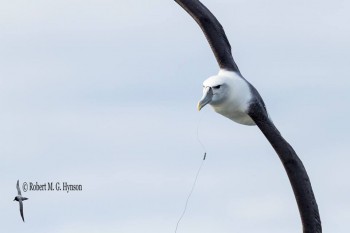Dominic Rollinson (FitzPatrick Institute, University of Cape Town, South Africa) and colleagues have published in the African Journal of Marine Science on the numbers of seabirds estimated killed by foreign and domestic pelagic longliners around South Africa.
The paper’s abstract follows:
“Both foreign and domestic pelagic longline fishing vessels operate in South Africa’s Exclusive Economic Zone and adjacent international waters where they kill hundreds of seabirds each year as bycatch. To update assessments of the impact of the pelagic longline fishery on seabirds off South Africa, information on necropsied seabirds and national fisheries observer bycatch records were summarised for 2006–2013. Foreign-flagged (Asian) vessels had 100% observer coverage throughout the study period, whereas only 6% of the fishing effort by South African-flagged vessels was observed (with no coverage in 2011–2013). Vessels with observers caught seabirds at a rate of 0.132 birds per 1 000 hooks, resulting in an estimated mortality of 2 851 individuals (356 per year) comprising 14 species. Extrapolation of the observed fishing sets to the unobserved fishing sets by the South African domestic longline fleet suggested that approximately 750 additional birds were likely killed during the study period, therefore a combined 450 birds were killed per year. White-chinned petrel Procellaria aequinoctialis was the most frequently killed species (66%), followed by ‘shy-type’ albatrosses Thalassarche cauta/steadi (21%), black-browed albatross T. melanophris (7%), Indian yellow-nosed albatross T. carteri (3%), and Cape gannet Morus capensis (2%). The seabird bycatch rates were lower than in 1998–2005. Nationality of the vessel, time of line-setting, moon phase, year, season, fishing area, and seabird bycatch mitigation measures all influenced seabird mortality. Concurrent with 100% observer coverage, significant reductions in the seabird bycatch rate occurred in the Asian fleet in the latter years of the study, and these rates now approximate the national target (0.05 birds per 1 000 hooks). However, seabird bycatch rates remained high in the South African fleet, where no observers were deployed during 2011–2013, highlighting the need for independent observer programmes in fisheries - a matter of global interest. Suggestions are made as to how seabird bycatch by pelagic longline fisheries off South Africa may be further reduced.”

A Shy Albatross trails a fishing line, photograph by Robert Hynsco
Reference:
Rollinson, D.P., Wanless, R.M. & Ryan, P.G. 2017. Patterns and trends in seabird bycatch in the pelagic longline fishery off South Africa. African Journal of Marine Science 39: 9-25.
John Cooper, ACAP Information Officer, 21 July 2017

 English
English  Français
Français  Español
Español